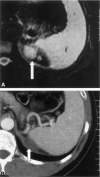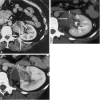Radiofrequency ablation of adrenal tumors and adrenocortical carcinoma metastases
- PMID: 12548596
- PMCID: PMC2443414
- DOI: 10.1002/cncr.11084
Radiofrequency ablation of adrenal tumors and adrenocortical carcinoma metastases
Abstract
Background: The current study was performed to analyze the feasibility, safety, imaging appearance, and short-term efficacy of image-guided percutaneous radiofrequency ablation (RFA) of primary and metastatic adrenal neoplasms including adrenocortical carcinoma.
Methods: The procedure was performed using 36 treatment spheres on 15 adrenocortical carcinoma primary or metastatic tumors in eight patients over 27 months. Tumors ranged from 15 to 90 mm in greatest dimension with a mean of 43 mm. All patients had unresectable tumors or were poor candidates for surgery. Mean follow-up was 10.3 months.
Results: All patients were discharged or were free of procedure-related medical care 6-48 hours after the procedures without major complications. All treatments resulted in presumptive coagulation necrosis by imaging criteria, which manifested as loss of previous contrast enhancement in ablated tissue. Eight of 15 (53%) posttreatment thermal lesions lost enhancement and stopped growing on latest follow-up computed tomographic scan. Three of 15 (20%) demonstrated interval growth and four did not change in size. Of these four lesions, two showed contrast enhancement. For smaller tumors with a mean greatest dimension less than or equal to 5 cm, 8 of 12 (67%) tumors were completely ablated, as defined by decreasing size and complete loss of contrast enhancement. Three of 15 (20 %) tumors and related thermal lesions were found to have disappeared nearly completely on imaging.
Conclusions: Percutaneous, image-guided RFA is a safe and well tolerated procedure for the treatment of unresectable primary or metastatic adrenocortical carcinoma. The procedure is effective for the short-term local control of small adrenal tumors, and is most effective for tumors less than 5 cm. The survival rate for patients with adrenocortical carcinoma improves when radical excision is performed in selected patients. Aggressive local disease control may potentially influence survival as well. However, further study is required to evaluate survival impact, document long-term efficacy, and to determine if RFA can obviate repeated surgical intervention in specific clinical scenarios.
Figures




Similar articles
-
[Efficacy of radiofrequency ablation to treat advanced hepatocellular carcinoma].Zhonghua Gan Zang Bing Za Zhi. 2012 Apr;20(4):256-60. doi: 10.3760/cma.j.issn.1007-3418.2012.04.006. Zhonghua Gan Zang Bing Za Zhi. 2012. PMID: 22964144 Chinese.
-
Thermal Ablation in the Management of Adrenal Metastasis Originating from Non-small Cell Lung Cancer: A 5-year Single-center Experience.Chin Med J (Engl). 2017 Sep 5;130(17):2027-2032. doi: 10.4103/0366-6999.210496. Chin Med J (Engl). 2017. PMID: 28707652 Free PMC article.
-
Ultrasound-guided radiofrequency thermal ablation of liver tumors: percutaneous, laparoscopic, and open surgical approaches.J Gastrointest Surg. 2001 Sep-Oct;5(5):477-89. doi: 10.1016/s1091-255x(01)80085-8. J Gastrointest Surg. 2001. PMID: 11985998
-
Malignant adrenal tumors.Semin Pediatr Surg. 2006 Feb;15(1):48-56. doi: 10.1053/j.sempedsurg.2005.11.008. Semin Pediatr Surg. 2006. PMID: 16458846 Review.
-
[ADRENOCORTICAL CARCINOMA].Acta Med Croatica. 2016 Dec;70(4-5):315-8. Acta Med Croatica. 2016. PMID: 29087170 Review. Croatian.
Cited by
-
Terminology and reporting criteria for radiofrequency ablation of tumors in the scientific literature: systematic review of compliance with reporting standards.Korean J Radiol. 2014 Jan-Feb;15(1):95-107. doi: 10.3348/kjr.2014.15.1.95. Epub 2014 Jan 8. Korean J Radiol. 2014. PMID: 24497798 Free PMC article.
-
Image guided tumour ablation.Cancer Imaging. 2005 Sep 21;5(1):103-9. doi: 10.1102/1470-7330.2005.0015. Cancer Imaging. 2005. PMID: 16305946 Free PMC article. Review.
-
Disease-free interval and tumor functional status can be used to select patients for resection/ablation of liver metastases from adrenocortical carcinoma: insights from a multi-institutional study.HPB (Oxford). 2020 Jan;22(1):169-175. doi: 10.1016/j.hpb.2019.07.002. Epub 2019 Aug 22. HPB (Oxford). 2020. PMID: 31447392 Free PMC article.
-
The Overall Survival and Progression-Free Survival in Patients with Advanced Adrenocortical Cancer Is Increased after the Multidisciplinary Team Evaluation.Cancers (Basel). 2022 Aug 12;14(16):3904. doi: 10.3390/cancers14163904. Cancers (Basel). 2022. PMID: 36010898 Free PMC article.
-
Management of adrenal cancer: a 2013 update.J Endocrinol Invest. 2014 Mar;37(3):207-17. doi: 10.1007/s40618-013-0049-2. J Endocrinol Invest. 2014. PMID: 24458831 Review.
References
-
- Demeure MJ, Somberg LB. Functioning and nonfunctioning adrenocortical carcinoma. Surg Oncol Clin North Am. 1998;7:791–805. - PubMed
-
- Luton JP, Cerdas S, Billaud L, et al. Clinical features of adrenocortical carcinoma, prognostic factors and the effect of mitotane therapy. N Engl J Med. 1990;332:1195–1201. - PubMed
-
- Vassilopoulou-Sellin R, Guinee VF, Klein MJ, et al. Impact of adjuvant mitotane on the clinical course of patients with adrenocortical cancer. Cancer. 1993;71:3119–3123. - PubMed
-
- Decker RA, Elson P, Hogan TF, et al. Eastern Cooperative Oncology Group study 1879: mitotane and Adriamycin in patients with advanced adrenocrtical carcinoma. Surgery. 1991;110:1006–1013. - PubMed
-
- Bukowski RM, Wolfe M, Levine HS, et al. Phase II trial of mitotane and cisplatin in patients with adrenal carcinoma: a Southwest Oncology Group Study. J Clin Oncol. 1993;11:161–165. - PubMed
Publication types
MeSH terms
Grants and funding
LinkOut - more resources
Full Text Sources
Medical

